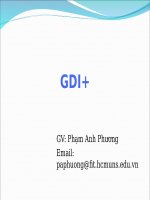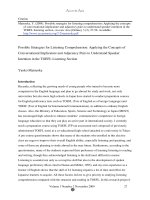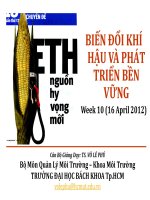Week 10 recap applying key concepts
Bạn đang xem bản rút gọn của tài liệu. Xem và tải ngay bản đầy đủ của tài liệu tại đây (1.83 MB, 35 trang )
3BM020:
Organisational Strategy
and Decision Making
Strategy and Tesco:
Applying key concepts
Learning outcomes
• Recap key strategic concepts
• Understand the language of
strategy
• Apply an understanding of
strategic concepts to Tesco*
*Reminder: Tesco cannot be used for
your report
Definitions of strategy
The determination of the long-run goals and objectives of an enterprise
and the adoption of courses of action and the allocation of resource
necessary for carrying out these goals”
Alfred D. Chandler
“Competitive strategy is about being different. It means deliberately
choosing a different set of activities to deliver a unique mix of value”
Michael Porter
“A pattern in a stream of decisions”
Henry Mintzberg
“The long-term direction of an organisation”
Exploring Strategy
Emergence of strategy
• Strategy occurs in response to competition
• The environment in which firms operate changes –
therefore strategies need to change
• Ansoff introduced the concept of turbulent
environments; this will link into notions of prescriptive
and emergent strategies
• Porter considered achieving competitive advantage as
the goal of organisations
• Penrose highlighted the internal role of the organisation
– became knows as the resource-based view (RBV) and
links to resources and competences (strategic
capabilities)
Strategy and Tesco
• 1929: opened the first store
• Arguably a cost leadership, broad target
strategy (Generic Strategy)
• 1990s recession – introduced “Value”
range (changing environment + move to
hybrid or differentiation on the Strategy
Clock?)
• 1996 – overtook Sainsbury’s as UK’s
biggest grocer: How?
Strategy and Tesco
• 1995 – Tesco Clubcard – a game changer:
unique resource and distinctive capability
which altered the industry structure (5
Forces)
• Gave access to raw data – achieve
competitive advantage
• Size of company’s orders allowed aggressive
negotiation with suppliers (Porters Generic
Strategies and 5 Forces model)
Tesco clubcard and strategy
• Fundamentally changed the way all
supermarkets did business
• Distinctive capability to gain
competitive advantage
• ...but the environment changes...
• ...did this become a threshold
capability?
• ...how did the industry respond?
In the news: Tesco Clubcard
Tesco and strategy continued
• 1996 onwards:
• Large investment in land and buildings
resources – unique but not imitable? Could
other organisations buy that level of land?
• Created the ‘out of town’ shopping experience
– a unique resource? Why?
• Diversification: bank, insurance, credit cards
loans, flat-screen TV, mobile phone, clothes,
bread, milk and butter (differentiation?)
Resource-based view (RBV) of
Strategy
• developed to answer the question: Why do
some firms achieve better economic
performance than others?
• used to help firms achieve competitive
advantage and superior economic
performance
• assumes that a firm’s resources and
capabilities are the primary drivers of
competitive advantage and economic
performance
Tesco 2014
• Tesco in trouble
• What does it mean for the company?
• Based on history, business analysts feel
that the chain will probably adapt and
change...but could there be a sense of
path dependency?
• How? What does Tesco need to do? What
tools could be used to interpret and
understand where Tesco is strategically?
Strategic positioning
• Impact on strategy of the external environment,
the organisation’s strategic capability, goals, and
organisational culture
• Environment can fluctuate (turbulent)
• PESTLE analysis – look at environments – identify
key drivers for change – build scenarios
Environmental analysis allows organisations to:
• better understand the nature of competition
• discover threats and opportunities
• make more informed strategic choices
Porter: generic strategies
Cost leadership
Cost-leadership strategy involves becoming the
lowest-cost organisation in a domain of activity
Four key cost drivers that can help deliver cost
leadership:
• Lower input costs
• Economies of scale
• Experience
• Product process and design
The Experience Curve
Company A has
unit costs here
Company B has
unit costs here
Differentiation strategies
Differentiation involves
uniqueness along some
dimension that is
sufficiently valued by
customers to allow a price
premium
The strategy clock
Is Tesco ‘stuck in the middle’?
Porter’s argues:
• It is best to choose which generic strategy to
adopt and then stick rigorously to it.
• Failure to do this leads to a danger of being
‘stuck in the middle’ i.e. doing no strategy well.
• The argument for pure generic strategies is
controversial. Even Porter acknowledges that
the strategies can be combined (e.g. if being
unique costs nothing).
Has being stuck in the middle led to strategic
drift for Tesco? How could this be diagnosed?
Strategic capabilities:
resources and competences
• Strategic capabilities: “the capabilities of
an organisation that contribute to its longterm survival or competitive advantage”
• Resources: “the assets that organisations
have or can call upon” (what we have)
• Competences: “the ways those assets are
used or deployed effectively” (what we do
well)
Threshold Capabilities (1)
• Threshold capabilities: those essential to
compete in a given market, those necessary to
achieve parity with competitors in the market
– ‘qualifiers’
• Required to be “in the game”
• Threshold levels change over time (why?)
• changes in Critical Success Factors
• new entrants
• competitor activity
Threshold Capabilities (2)
• Distinctive capabilities are those
that are required to achieve
competitive advantage. Distinctive or
unique capabilities that are of value
to customers and which competitors
find difficult to imitate – ‘winners’.
What are Tesco’s distinctive
capabilities?
Strategic capabilities
Dynamic capabilities are the means by which an
organisation has the ability to renew and
recreate its strategic capabilities to meet the
needs of changing environments.
Such capabilities are distinct from ordinary
capabilities that may be necessary to operate
efficiently now but that may not be sufficient to
sustain superior performance in the future.
Redundant capabilities
• Capabilities, however effective in
the past, can become less relevant
as industries evolve and change.
• Such ‘capabilities’ can become
‘rigidities’ that inhibit change and
become a weakness
Rigidities, path dependency
and strategic drift....
• Has the out of town shopping
centre become redundant now?
• Is this because of social change?
Economic change....other key
drivers of change which could be
diagnosed by PESTLE analysis?









